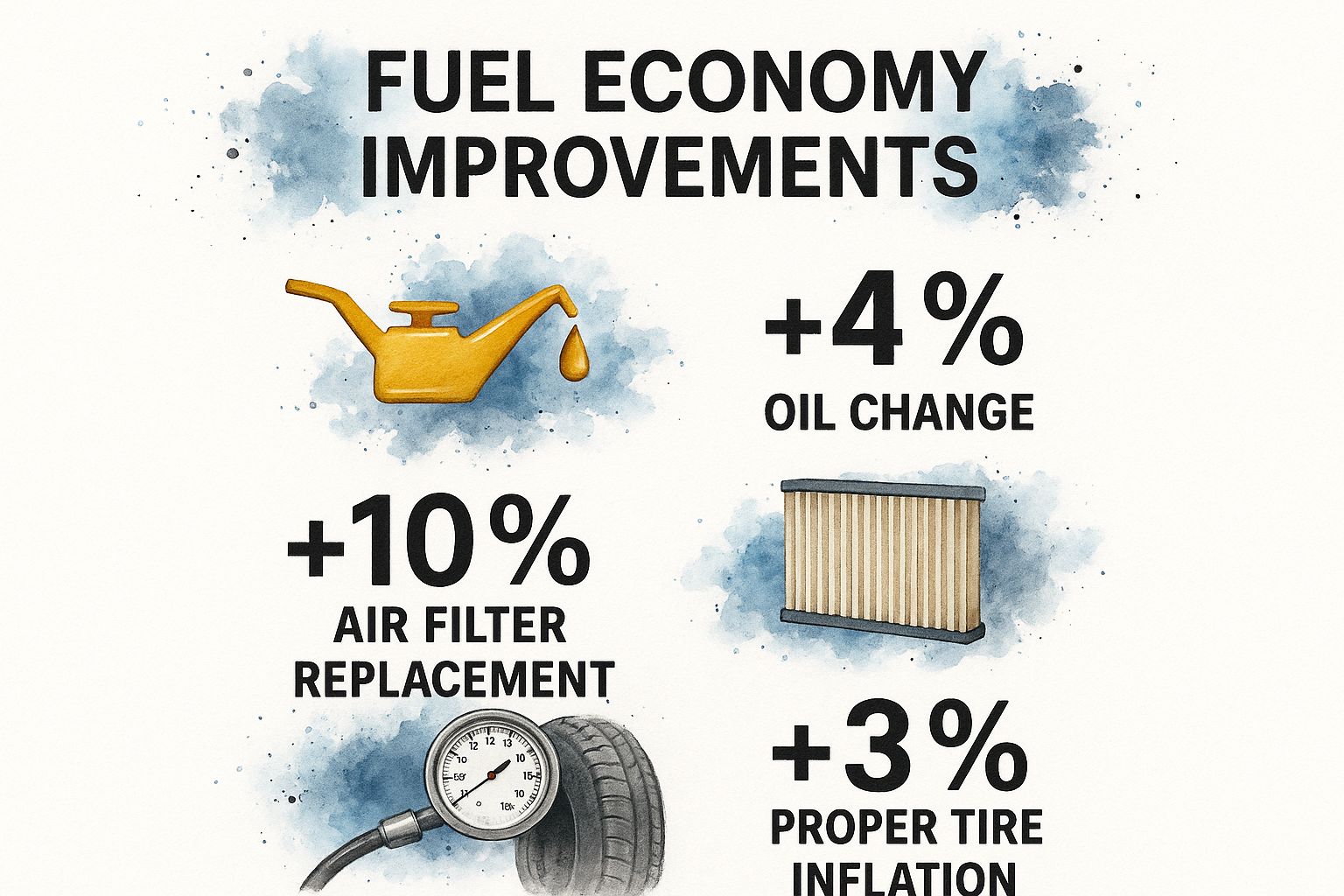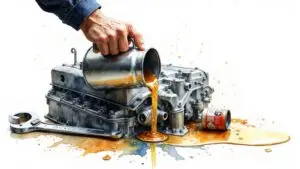Fuel Savings Unleashed: Your Guide to Boosting MPG
Want to increase mpg and save money on gas? This listicle provides seven practical tips to boost your vehicle's fuel efficiency. Learn how regular maintenance, weight reduction, driving habits, aerodynamics, tires, engine tuning, and trip planning can all contribute to better gas mileage. Whether you're a daily commuter in Haltom City, Keller, Watauga, or North Richland Hills, TX, or manage a fleet of company vehicles, these strategies will help you get the most out of every gallon.
1. Regular Vehicle Maintenance
One of the most effective ways to increase mpg and save money at the pump is through consistent vehicle maintenance. This isn't just about keeping your car running smoothly; it directly impacts how efficiently your engine burns fuel and how much resistance your vehicle faces on the road. From simple checks like tire pressure to more involved procedures like spark plug replacements, maintaining your vehicle's vital components can significantly boost your fuel economy.

The infographic below visualizes key data related to the impact of regular maintenance on fuel efficiency and overall vehicle health.

As the infographic highlights, neglecting regular maintenance can lead to a significant drop in fuel efficiency, with issues like low tire pressure and clogged air filters contributing to a substantial decrease in MPG. Conversely, addressing these issues through routine check-ups and part replacements can noticeably improve your gas mileage. For example, simply inflating tires to the correct pressure can improve fuel economy by up to 3%, while a clean air filter can boost it by as much as 10% in older vehicles. Regular oil changes ensure the engine runs smoothly with minimal friction, also contributing to better MPG.
Features of a good vehicle maintenance schedule include regular oil changes, air filter replacements, spark plug maintenance, tire pressure monitoring, and occasional engine tune-ups. These procedures not only improve fuel economy but also extend the lifespan of your vehicle and reduce overall repair costs in the long run. A 2019 study by the Car Care Council found that fixing a vehicle that failed an emissions test improved fuel economy by an average of 4%. Consumer Reports tests have also shown that driving with dirty air filters can reduce MPG by up to 10% in older models.
Pros:
- Relatively low cost for significant MPG improvements: Basic maintenance tasks are much cheaper than major repairs down the line.
- Extends vehicle lifespan: Proper maintenance keeps your car running smoothly for longer.
- Reduces overall repair costs: Preventing problems through maintenance is more cost-effective than fixing major issues.
- Can improve MPG by up to 4-10%: This translates to real savings at the gas pump.
Cons:
- Requires ongoing time commitment: Scheduling and performing maintenance takes time and effort.
- Some maintenance requires professional service: Not all tasks are DIY-friendly.
- Benefits accumulate gradually rather than immediately: While impactful, the benefits of maintenance are realized over time.
Tips for maximizing your MPG through maintenance:
- Follow manufacturer-recommended maintenance schedules: This is the best way to ensure your car stays in top condition.
- Check tire pressure monthly: Properly inflated tires reduce rolling resistance and improve fuel economy.
- Replace air filters every 15,000-30,000 miles: A clean air filter ensures efficient combustion.
- Use manufacturer-recommended motor oil: The right oil viscosity is crucial for engine performance and fuel efficiency.
- Address check engine lights promptly: Ignoring warning signs can lead to bigger problems and reduced MPG.
This approach is essential for all vehicle owners in Haltom City, Keller, Watauga, and North Richland Hills, TX, including local drivers, busy professionals, fleet managers, and anyone prioritizing safety and fuel efficiency. Regular maintenance deserves its place at the top of this list because it's a foundational step for achieving optimal fuel economy and ensuring the long-term health of your vehicle. By investing a little time and effort into regular maintenance, you can significantly increase your mpg, save money, and enjoy a more reliable and efficient driving experience.
2. Weight Reduction
Shedding unnecessary pounds isn't just good for your health; it's beneficial for your vehicle's fuel economy too. Weight reduction is a simple yet effective method for increasing mpg, deserving its place on this list because it offers immediate impact with little to no cost. Every 100 pounds removed from your vehicle can boost your MPG by approximately 1-2%. This might not seem like a massive jump, but it adds up over time, especially for frequent drivers in Haltom City, Keller, Watauga, North Richland Hills, and surrounding areas. By understanding how weight impacts fuel consumption and adopting a few practical strategies, you can make your gas tank go further.
How It Works: Your engine works harder to move a heavier vehicle. More work means more fuel consumed. By reducing the weight your engine has to propel, you decrease the demand on your engine and consequently, improve how to increase mpg.
Features of Weight Reduction for Increased MPG:
- Removal of unnecessary cargo: This is the most straightforward approach.
- Roof rack removal when not in use: Roof racks create aerodynamic drag, even when empty. Removing them when you don't need them is a quick win for better fuel economy.
- Potential component replacement with lighter materials (advanced): While more involved and potentially costly, replacing heavier components with lighter alternatives (like aluminum wheels) can contribute to significant weight savings.
Pros:
- Immediate impact on fuel economy: You'll see a difference as soon as you lighten your load.
- No cost (or even profitable): Removing unnecessary items is free. Selling unwanted items can even put money in your pocket.
- No technical knowledge required: Anyone can clean out their vehicle.
- Can improve handling and braking: A lighter vehicle is generally more responsive and stops quicker.
Cons:
- Limited overall impact compared to other strategies: While effective, weight reduction alone won’t drastically improve your MPG compared to engine tuning or tire pressure management.
- May require sacrificing convenience: You might need to reconsider carrying certain items regularly.
- Significant weight reduction might require costly modifications: Replacing components for the sole purpose of weight reduction can be expensive.
Examples of Successful Implementation:
- NASCAR: In the world of professional racing where every fraction of a second counts, NASCAR teams understand the importance of weight. They meticulously strip down their cars, removing every unnecessary ounce to improve speed and fuel efficiency.
- Toyota Prius: Toyota employed rigorous weight-saving strategies in the design of the Prius, contributing to its exceptional fuel economy.
Actionable Tips to Increase MPG by Reducing Weight:
- Routinely clean out your trunk and cargo areas: Don't let your vehicle become a storage unit. Regularly remove anything you don’t need for your commute or errands.
- Remove roof racks and carriers when not in use: This simple step improves aerodynamics and fuel efficiency.
- Consider leaving optional equipment at home on long trips: If you're traveling and don't need specific sporting equipment, tools, or other heavy items, leave them behind.
- Maintain only the emergency items you actually need: Evaluate your emergency kit and remove expired or unnecessary items. A lighter, more practical kit serves you better.
When and Why to Use This Approach:
Weight reduction is a valuable strategy for any driver looking to how to increase mpg, particularly for those in our local community where commutes and errands can add up. It's particularly beneficial for:
- Local vehicle owners: Around-town driving often involves carrying unnecessary items.
- Busy professionals: Clearing out work-related items at the end of the day can improve your commute.
- Fleet managers and business owners: Encouraging employees to maintain clean company vehicles can save on fuel costs across the entire fleet.
- Safety-conscious drivers: A lighter vehicle generally handles and brakes better, improving safety.
By implementing these simple weight reduction tips, you can experience an immediate improvement in your fuel economy, saving money and reducing your environmental impact.
3. Efficient Driving Techniques
One of the most effective ways to increase mpg and lower your fuel costs is by adopting efficient driving techniques. How you drive has a significant impact on fuel consumption. These techniques focus on smooth acceleration and braking, maintaining steady speeds, avoiding excessive idling, and using cruise control strategically. By minimizing unnecessary engine strain and optimizing momentum, you can significantly reduce the amount of fuel your vehicle burns.

Efficient driving isn't just about saving money at the pump; it also contributes to reducing vehicle wear and tear and even enhances safety. Features of this approach include gradual acceleration, anticipatory driving (looking ahead to reduce braking), maintaining optimal speeds, minimizing idling time, and the strategic use of cruise control. This method deserves its place on this list because it's a zero-cost way to see immediate fuel economy improvements, often boosting MPG by 10-40%. For busy professionals in areas like Haltom City, Keller, Watauga, and North Richland Hills, TX, where time is valuable, even small improvements in fuel efficiency can add up to significant savings over time. Fuel efficiency also ties in with overall operational efficiency. By streamlining processes and reducing unnecessary actions, you can minimize fuel consumption and maximize your resources. For more insights into optimizing efficiency, check out this resource on improve operational efficiency.
While the benefits are substantial, there are some drawbacks to consider. Changing ingrained driving habits requires conscious effort and may initially feel unnatural. It might also slightly increase travel times, especially when learning to anticipate traffic flow. Some efficient driving techniques, such as maintaining steady speeds, are also difficult to implement in congested traffic conditions common in urban areas.
The effectiveness of efficient driving is clearly demonstrated by professional hypermilers who, through extreme techniques, achieve 2-3 times the EPA-rated MPG for their vehicles. Large companies like UPS also recognize the value of these techniques, training their drivers to save millions of gallons of fuel annually.
Tips for increasing MPG through efficient driving:
- Accelerate Gently: Imagine an egg between your foot and the pedal to avoid rapid acceleration.
- Anticipate Traffic Flow: Look ahead and anticipate traffic changes to minimize braking. Coasting to a stop when safe is a great way to save fuel.
- Use Cruise Control: On highways and open roads, cruise control helps maintain a consistent speed, maximizing fuel efficiency.
- Maintain Optimal Speeds: Driving at or slightly below the speed limit significantly reduces fuel consumption.
- Avoid Excessive Idling: Turn off your engine if you anticipate idling for more than 30 seconds.
By implementing these simple yet effective tips, drivers in the DFW area, whether they are local vehicle owners, fleet managers, or busy professionals, can significantly how to increase mpg and contribute to both their personal budgets and a greener environment. The methods popularized by Wayne Gerdes (who coined the term "hypermiling") and initiatives like EcoDriving USA further demonstrate the widespread recognition and adoption of efficient driving techniques.
4. Aerodynamic Improvements
Aerodynamics plays a crucial role in fuel efficiency, especially at higher speeds. This method focuses on reducing the resistance your vehicle encounters as it moves through the air. Less resistance means your engine has to work less, directly translating to increased miles per gallon (mpg). For drivers in Haltom City, Keller, Watauga, North Richland Hills, and surrounding areas, where highway driving is common, understanding and implementing these strategies can lead to significant fuel savings.
How it Works:
As your vehicle moves, it pushes air out of the way. The force required to do this is called aerodynamic drag. The shape of your vehicle, along with any attached accessories, significantly impacts this drag. By streamlining your vehicle's profile, you can reduce drag and improve how to increase mpg.
Features and Benefits:
- Window Management: Keeping your windows closed at higher speeds prevents air from entering the cabin and disrupting the smooth airflow around the vehicle. While open windows might seem insignificant, they can create substantial turbulence, especially at highway speeds.
- Removal of Roof Accessories: Roof racks, cargo boxes, bicycle racks, and even flag poles create significant drag. Removing these items when not in use drastically reduces resistance and improves fuel economy.
- Aftermarket Aerodynamic Additions: While potentially costly, aftermarket additions like air dams, underbody panels, and fairings can further smooth airflow and reduce drag. These modifications are especially beneficial for trucks and SUVs.
- Ride Height Adjustments: Lowering your vehicle can also marginally reduce drag by minimizing the area exposed to oncoming air. However, be mindful of ground clearance and potential scraping issues.
Pros:
- Highway Efficiency: Aerodynamic improvements are most effective at higher speeds, making them ideal for highway driving, a common occurrence for those commuting between Haltom City, Keller, and other parts of the DFW area.
- Cost-Effective Options: Many aerodynamic improvements, like removing roof racks or keeping windows closed, are completely free.
- Synergy with Other Strategies: Aerodynamic enhancements complement other fuel-saving techniques, such as proper tire inflation and efficient driving habits, for even greater mpg gains.
- Improved Stability: Some aerodynamic modifications, particularly those that add downforce, can improve high-speed handling and stability.
Cons:
- Cost of Modifications: Extensive modifications like underbody panels or custom fairings can be expensive.
- Aesthetic Changes: Some aerodynamic additions may alter your vehicle's appearance, which may not be desirable for all drivers.
- Limited Low-Speed Benefit: The benefits of aerodynamic improvements are less noticeable at lower speeds, such as city driving.
- Warranty Concerns: Significant modifications could potentially void manufacturer warranties. Consult your vehicle's warranty information before making any significant changes.
Examples of Successful Implementation:
- The Tesla Model 3, known for its exceptional efficiency, achieves a remarkably low drag coefficient of 0.23, contributing significantly to its range.
- Trucking companies routinely utilize aerodynamic fairings on their trailers to significantly reduce drag, resulting in fuel savings of 3-7%, a considerable improvement when operating large fleets.
Actionable Tips for Increasing MPG through Aerodynamics:
- Keep windows closed and utilize the A/C at highway speeds. This often provides better fuel economy than open windows.
- Remove roof racks, flags, or antenna toppers when not in use. These seemingly small items can have a surprising impact on drag.
- Consider a pickup truck bed cover (tonneau cover) to reduce drag in the truck bed. This is a relatively inexpensive and effective way to improve aerodynamics.
- Maintain factory aerodynamic components like air dams and spoilers. These components are designed to optimize airflow.
Why This Deserves a Place on the List:
Aerodynamic improvements provide a tangible way to how to increase mpg, particularly for highway drivers. While some modifications might require an investment, many are simple and free, making this a practical and accessible method for anyone looking to improve their fuel economy. For busy professionals, fleet managers, and safety-conscious drivers in the DFW metroplex, maximizing fuel efficiency is not just about cost savings, but also about reducing environmental impact and enhancing overall vehicle performance.
5. Tire Selection and Maintenance
One of the most overlooked yet effective ways to increase mpg is through proper tire selection and maintenance. Your tires create rolling resistance – the force required to keep them rolling – which directly impacts your fuel economy. By minimizing this resistance, you can improve how many miles you get per gallon of gas. This is achieved through a combination of choosing the right tires and keeping them in optimal condition. This approach is particularly relevant for how to increase mpg, offering a relatively affordable and straightforward path to better fuel efficiency.

Low Rolling Resistance (LRR) tires are specifically engineered to minimize rolling resistance. Their specialized tread patterns, internal construction, and rubber compounds reduce energy loss as the tire rolls, leading to better fuel economy. However, the benefits extend beyond simply choosing LRR tires. Proper tire maintenance, including regular inflation checks, rotations, and alignments, ensures optimal contact with the road, further reducing rolling resistance and maximizing your MPG. This is important for all drivers, especially those in Haltom City, Keller, Watauga, and North Richland Hills, TX, looking for ways to improve their vehicle's efficiency and save on fuel costs.
Examples of Successful Implementation:
- Michelin's Energy Saver line of tires has been shown to improve fuel economy by up to 3% compared to standard tires. This translates to real savings at the pump.
- The U.S. Department of Energy estimates that maintaining proper tire inflation alone can boost gas mileage by up to 3%. This simple maintenance step can make a significant difference.
Actionable Tips for Increasing MPG through Tire Selection and Maintenance:
- Check Tire Pressure Regularly: Check your tire pressure at least monthly and before any long trips. Use a reliable tire pressure gauge and inflate tires to the manufacturer's recommended pressure, which is listed on the sticker inside your driver's side door jamb (not the maximum pressure listed on the tire sidewall).
- Invest in LRR Tires: Consider LRR tires when it's time to replace your current set. While potentially a larger initial investment than standard tires, the long-term fuel savings and improved MPG can make them a worthwhile purchase.
- Maintain Proper Wheel Alignment: Ensure your wheels are properly aligned. Misalignment can cause uneven tire wear and increased rolling resistance, negatively impacting your fuel efficiency. Schedule an alignment service as recommended by your vehicle manufacturer or if you notice any signs of misalignment like uneven tire wear or pulling to one side.
- Rotate Tires Regularly: Rotate your tires according to the recommended intervals in your vehicle's owner's manual. This promotes even wear and extends the life of your tires, indirectly contributing to optimal fuel efficiency.
Pros and Cons:
Pros:
- Relatively affordable upgrade pathway (especially maintenance aspects)
- Maintenance requires no specialized equipment
- Improves safety alongside efficiency
- Can enhance ride comfort
Cons:
- LRR tires may have slightly reduced traction in extreme conditions (snow, ice) compared to some performance tires.
- Premium LRR tires can be more expensive than standard tires.
- Requires ongoing monitoring and maintenance.
This item deserves its place on the list because tire selection and maintenance offer a practical and cost-effective way to increase mpg for how to increase mpg. By combining smart tire choices with regular maintenance, drivers in the DFW area, including Haltom City, Keller, Watauga, and North Richland Hills, can significantly improve their vehicle's fuel efficiency, save money on gas, and contribute to a greener environment. Whether you are a busy professional, fleet manager, or simply a safety-conscious driver, optimizing your tires is a smart step toward better MPG and overall vehicle performance.
6. Engine Modifications and Tuning
Looking for ways to significantly boost your car's fuel efficiency? Engine modifications and tuning offer a path to increased MPG, but it's a path that requires careful consideration and research. This method involves optimizing your vehicle's engine and related systems to improve fuel combustion and overall efficiency. These adjustments can range from simple software tweaks to more complex mechanical alterations affecting how your engine processes fuel and air. If you're in Haltom City, Keller, Watauga, or North Richland Hills, TX, and seeking ways to increase mpg, this option might be worth exploring with a trusted local mechanic.
How it Works:
At its core, engine tuning aims to fine-tune the delicate balance of air and fuel delivered to the engine's cylinders. By optimizing this process, you can achieve more complete combustion, extracting more energy from each drop of fuel. This can involve adjusting parameters like ignition timing, fuel injection timing, and air intake volume.
Features and Benefits:
Several modifications can contribute to improved fuel economy:
- ECU (Engine Control Unit) Remapping/Tuning: This is the most common method, involving adjusting the engine's computer software to optimize various parameters. It’s like giving your engine a smarter brain to manage fuel consumption.
- High-Flow Air Filters: These filters allow more air to reach the engine, improving combustion efficiency.
- Low-Restriction Exhaust Systems: These systems facilitate quicker expulsion of exhaust gases, further enhancing engine breathing and efficiency.
- Fuel System Upgrades: These might include upgraded fuel injectors or pumps, ensuring optimal fuel delivery.
- Ignition Timing Optimization: Precisely timed ignition ensures the fuel-air mixture burns most efficiently.
Pros:
- Significant Performance and Efficiency Gains: Tuning can often deliver both increased horsepower and better MPG, a winning combination for many drivers.
- Customizable to Specific Vehicles and Driving Conditions: Tuning can be tailored to your specific vehicle and driving style, whether you're focused on city driving or highway cruising.
- Improved Drivability: Some modifications can lead to smoother acceleration and throttle response.
Cons:
- Cost: Professional tuning can be expensive, especially for more complex modifications.
- Warranty Concerns: Some modifications may void your manufacturer's warranty. Always check before proceeding.
- Technical Expertise Required: Improperly implemented modifications can damage your engine, so professional assistance is highly recommended.
- Reliability Risks: Incorrectly installed or poorly maintained modifications can reduce engine reliability.
- Emissions Compliance: Ensure any modifications comply with local emissions regulations.
Examples of Successful Implementation:
- Larger diesel trucks often achieve 2-4 MPG improvements with professional tuning, demonstrating the potential for substantial gains in larger vehicles.
- Honda's VTEC (Variable Valve Timing and Lift Electronic Control) technology is a factory example of variable timing implemented for both performance and efficiency.
Tips for Local Drivers in Haltom City, Keller, Watauga, and North Richland Hills, TX:
- Research Thoroughly: Before making any modifications, research options specific to your vehicle's make and model. Consult local mechanics specializing in performance tuning and ask about their experience with your specific vehicle type.
- Professional Tuning is Key: Avoid generic 'chips' or DIY solutions. Seek professional tuning from reputable shops in your area like those specializing in specific brands (e.g., APR, Cobb Tuning, Dinan).
- Track Your Results: Maintain detailed records of your fuel consumption before and after modifications to measure the actual benefits.
- Emissions Compliance is Essential: Ensure all modifications comply with Texas emissions regulations.
- Start Small: Begin with simpler, reversible modifications before undertaking major engine changes.
Why This Method Deserves Its Place on the List:
Engine modifications and tuning offer the potential for significant MPG increases, especially for certain vehicle types. While it's not the simplest or cheapest option, the potential rewards can be substantial for those seeking to maximize their fuel economy. However, it's crucial to proceed with caution, prioritize professional guidance, and thoroughly research the implications for your specific vehicle. This approach is particularly beneficial for drivers who prioritize fuel efficiency and are willing to invest in achieving noticeable improvements in how to increase mpg.
7. Trip Planning and Combining Errands
Want to learn how to increase mpg without spending a dime? One of the most effective strategies is trip planning and combining errands. This simple yet powerful technique involves strategically organizing your driving routes to minimize the total distance traveled and reduce the number of trips you take. By implementing this method, you can significantly boost your fuel efficiency and save money on gas.
This approach works on a few key principles:
- Route optimization: Finding the most efficient route to multiple destinations minimizes mileage and fuel consumption.
- Errand batching: Grouping several errands together into a single trip, rather than making multiple separate journeys.
- Cold-start reduction: Minimizing the number of times you start your car from a cold engine. Cold starts consume significantly more fuel than a warmed-up engine.
- Traffic avoidance planning: Scheduling trips to avoid peak traffic times when stop-and-go driving drastically reduces fuel economy.
- Destination sequencing: Ordering your errands in a logical sequence to create the shortest, most fuel-efficient route.
This method deserves its place on the list because it’s a zero-cost way to improve fuel economy and has the added benefits of saving time and reducing vehicle wear and tear. It's particularly beneficial for those who frequently run errands or have some flexibility in their schedules. However, it may be less practical for individuals with minimal discretionary driving or unpredictable schedules.
Examples of Successful Implementation:
- Logistics giants like UPS and FedEx utilize sophisticated route optimization software. UPS, famously, avoids left turns whenever possible, as idling while waiting to turn left burns more fuel. This strategy has reportedly saved them millions of gallons of fuel annually.
- Navigation apps such as Waze and Google Maps now offer fuel-efficient routing options, helping drivers find the most economical paths to their destinations.
Actionable Tips for Increasing MPG through Trip Planning:
- Plan errands in a circular route: Instead of driving back and forth, arrange your errands in a loop to minimize backtracking.
- Complete multiple tasks in geographically close areas: Group errands in the same neighborhood or shopping center together. Identify "cluster destinations" where multiple tasks can be accomplished in one stop.
- Schedule errands during off-peak traffic times: Avoiding rush hour can drastically improve fuel economy.
- Use navigation apps for optimal routes: Leverage tools like Google Maps to find the most fuel-efficient routes, considering current traffic conditions.
Pros:
- Zero cost implementation
- Saves time alongside fuel
- Reduces vehicle wear and tear
- Can be supported by navigation apps
- Reduces overall emissions
Cons:
- Requires advance planning
- May be challenging with unpredictable schedules
- Less effective for those with minimal discretionary driving
By adopting the simple strategies of trip planning and combining errands, you can take control of your fuel consumption and contribute to a greener environment, all while saving time and money. This practical approach is a winning solution for drivers seeking to how to increase mpg effectively and effortlessly.
7 Strategies to Boost MPG Comparison
| Strategy | 🔄 Implementation Complexity | ⚡ Resource Requirements | 📊 Expected Outcomes | 💡 Ideal Use Cases | ⭐ Key Advantages |
|---|---|---|---|---|---|
| Regular Vehicle Maintenance | Medium 🔄 | Moderate (professional service may be needed) | Medium to high (4-10% MPG improvement) | Routine vehicle upkeep, long-term owners | Cost-effective, extends vehicle life |
| Weight Reduction | Low 🔄 | Minimal to none | Low to medium (1-2% MPG per 100 lbs) | Everyday drivers seeking quick wins | Immediate effect, no cost |
| Efficient Driving Techniques | Low 🔄 | None | High (10-40% MPG improvement) | All drivers, especially in stop-go traffic | Zero cost, safety benefits |
| Aerodynamic Improvements | Medium to High 🔄 | Low to high (depending on modifications) | Medium (2-5% MPG at highway speeds) | Highway drivers, vehicles with roof loads | Effective at high speeds, complements other strategies |
| Tire Selection and Maintenance | Low 🔄 | Low to moderate (purchase of LRR tires) | Medium (3-7% MPG improvement) | Drivers needing affordable upgrades | Safety improvement, ride comfort |
| Engine Modifications and Tuning | High 🔄 | High (professional tuning, parts) | Variable (3-20% MPG improvement) | Enthusiasts, performance-oriented vehicles | High potential gains, customizable |
| Trip Planning and Combining Errands | Low 🔄 | None | Medium to high (10-20% fuel reduction) | Urban/errand-heavy drivers | Time and fuel savings, emission reduction |
Hit the Road with Confidence and Savings
Boosting your miles per gallon (mpg) isn't just about saving money at the pump; it's about maximizing your vehicle's performance and minimizing your environmental impact. We've covered seven key strategies to increase mpg: regular maintenance, weight reduction, efficient driving habits, aerodynamic enhancements, tire optimization, engine modifications, and smart trip planning. By incorporating even a few of these techniques, you can significantly improve your fuel efficiency and enjoy a more cost-effective driving experience. Remember, proper tire pressure, a well-maintained engine, and a lighter load can all contribute to substantial fuel savings over time. These improvements not only benefit your wallet but also reduce your carbon footprint, contributing to a cleaner environment for our communities in Haltom City, Keller, Watauga, and North Richland Hills, TX.
Mastering these approaches translates directly to more miles for your money and a smoother, more efficient ride. Whether you're a busy professional seeking reliable service, a fleet manager aiming to cut costs, or simply a driver looking to maximize your fuel economy, these strategies offer tangible benefits. How to increase mpg is a question with a multifaceted answer, and implementing even a few of these tips will put you well on your way to significant savings.
Ready to take your fuel efficiency to the next level? Express Lube & Car Care in Haltom City, Texas, can help you achieve optimal mpg through expert maintenance, tire services, and personalized advice. Visit Express Lube and Car Care today to learn more about how our certified technicians can help you improve your vehicle's performance and fuel economy.





